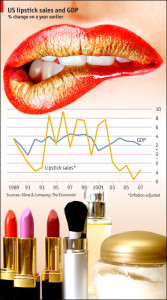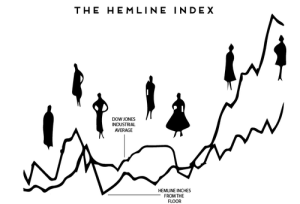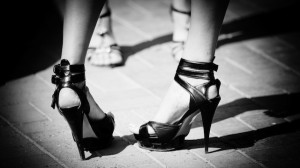Women consumers are a driving force in the market place, constantly shaping market patterns and trends. While new fashion and beauty trends seem to constantly be surfacing, many of these fashion trends aren’t as random as once thought. Though the latest issue of Vogue many seem like a collection of designer ideas and fashion revolutions much of women’s style runs in cycles. Further research into these cycles has revealed economic ties to woman’s buying habits.
 One of the more widely talked about economic indicators tied to women is the lipstick index. Leonard Lauder argued “that during difficult economic times, women will increase purchases of lipstick and makeup and decrease purchases of higher priced goods like shoes and handbags”. There are two major theories that support why women would increase their makeup buying habits in hard economic times. The first of these theories looks at the self-esteem of women and the need to have luxury goods even when unaffordable. Women’s fashion is branded from a desire standpoint not a need standpoint therefore women view items like handbags and shoes as items that increase their self-value. While money may run short women’s opinions of their own self-worth does not diminish at the same rate. This leads to women seeking desire goods that fit their new price point, such as lip stick.
One of the more widely talked about economic indicators tied to women is the lipstick index. Leonard Lauder argued “that during difficult economic times, women will increase purchases of lipstick and makeup and decrease purchases of higher priced goods like shoes and handbags”. There are two major theories that support why women would increase their makeup buying habits in hard economic times. The first of these theories looks at the self-esteem of women and the need to have luxury goods even when unaffordable. Women’s fashion is branded from a desire standpoint not a need standpoint therefore women view items like handbags and shoes as items that increase their self-value. While money may run short women’s opinions of their own self-worth does not diminish at the same rate. This leads to women seeking desire goods that fit their new price point, such as lip stick.
The second theory looks into the reasons why women buy makeup to begin with, with one of the main reasons being to increase their attraction level. A study conducted by a team of psychologists looked into this trend and noticed that as a recession occurred the number of men women found attractive decreased. This occurred for several reasons with the primary reason being women look for financial security in a partner as a major trait. Business Insider found that the “results of four separate experiments showed that women were likely to increase purchases of lipstick, perfume, and other products that might enhance their sex appeal.” While handbags and shoes might also enhance a women’s sex appeal, during economic downturn these expensive items fall into an unaffordable price range.

Women do not affect the market only with beauty sales but with fashion as well. George Taylor in the 1920s came across the Hemline Index. This index looks at the length of women’s garments juxtaposed to the state of the economy. In his research he found that the better the economy was doing the shorter the hemline fell on women’s clothing. Many economists have looked at this theory and found differing reasons. Some found that a longer hemline in economic downturn was a result of women wanting to appear more professional as they looked for jobs or tried to keep their jobs. This was backed up with dramatic length changes on women’s clothing during the 2008 financial crisis. On the opposite end other economist found that the shorter hemline in good economic times was a result of more disposable income being spent on partying and social use.

Women’s buying habits highlight a third economic indicator the High Heel Index. Dr. Trever Davis found that “Usually, in an economic downturn, heels go up and stay up – as consumers turn to more flamboyant fashions as a means of fantasy and escape”. While in the previous study it was shown that women tend to shy away from buying expensive items like shoes; this study has shown that those who still do purchase shoes purchase higher ones. The high heel has been correlated with a women’s confidence and an overall put together presentation. The association has led women to purchase higher shoes in harder times to in a way suppress reality.
Women have always been large consumers in the market place and studying their consumption patterns has given economist a different way of looking at the economy. While the standard economic statistics and figures are still used as the most credible way to gage the state of the economy looking at trends such as these provide a different perspective.
Leave a Reply
You must be logged in to post a comment.